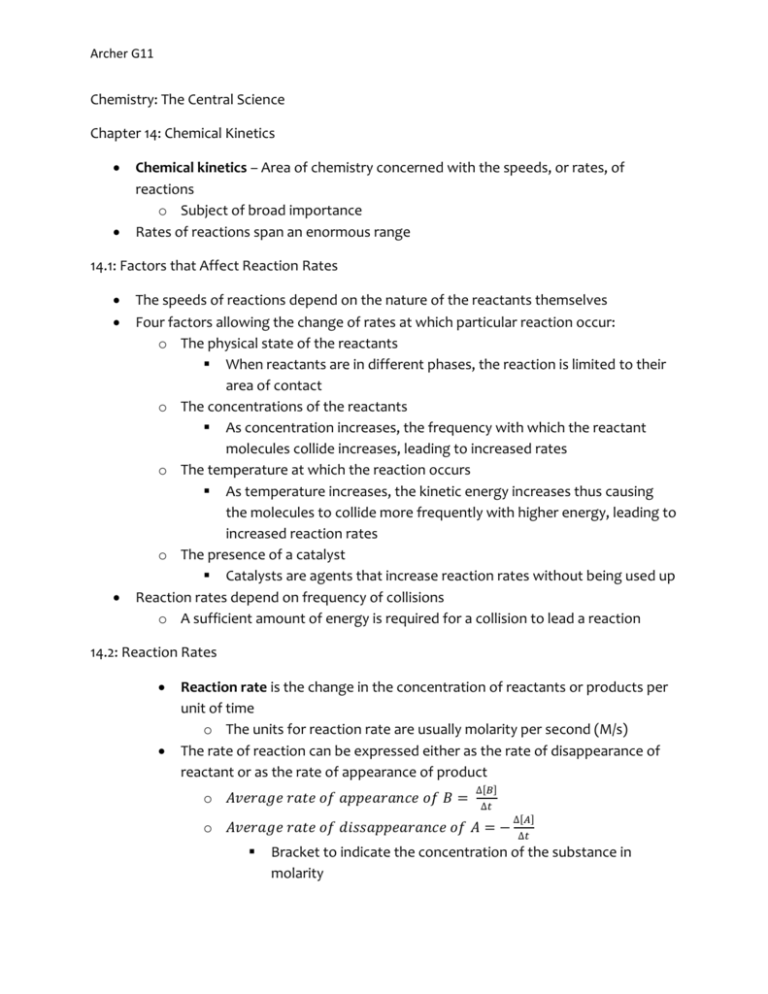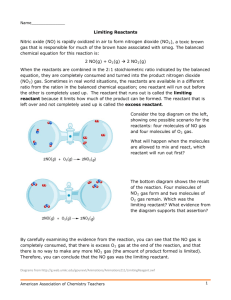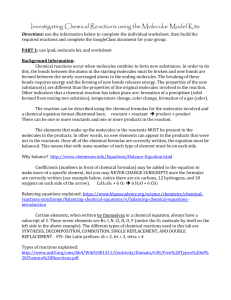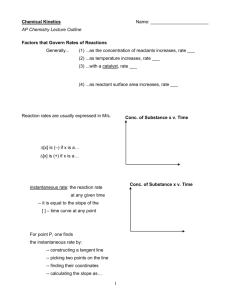Chemistry: The Central Science Chapter 14: Chemical Kinetics
advertisement

Archer G11 Chemistry: The Central Science Chapter 14: Chemical Kinetics Chemical kinetics – Area of chemistry concerned with the speeds, or rates, of reactions o Subject of broad importance Rates of reactions span an enormous range 14.1: Factors that Affect Reaction Rates The speeds of reactions depend on the nature of the reactants themselves Four factors allowing the change of rates at which particular reaction occur: o The physical state of the reactants When reactants are in different phases, the reaction is limited to their area of contact o The concentrations of the reactants As concentration increases, the frequency with which the reactant molecules collide increases, leading to increased rates o The temperature at which the reaction occurs As temperature increases, the kinetic energy increases thus causing the molecules to collide more frequently with higher energy, leading to increased reaction rates o The presence of a catalyst Catalysts are agents that increase reaction rates without being used up Reaction rates depend on frequency of collisions o A sufficient amount of energy is required for a collision to lead a reaction 14.2: Reaction Rates Reaction rate is the change in the concentration of reactants or products per unit of time o The units for reaction rate are usually molarity per second (M/s) The rate of reaction can be expressed either as the rate of disappearance of reactant or as the rate of appearance of product o o Bracket to indicate the concentration of the substance in molarity Archer G11 Negative sign in front of disappearance to make it positive o Rates are always expressed as positive quantities Change of Rate with Time o Over time, it is typical for rates to decrease as a reaction proceeds, because the concentration of reactants decreases Instantaneous Rate o Instantaneous rate is the rate at a particular moment in the reaction o Can be determined from the slope of the tangent line at the point o Instantaneous rate at t = 0 is called the initial rate Reaction Rates and Stoichiometry o The rate also depends on the stoichiometric relationship o Rate of reaction can be given by the equation below 14.3: Concentration and Rate Rate at the beginning of a reaction depends on the starting concentration Equation which shows how the rate depends on the concentrations of reactants is called a rate law o k in the rate law is called the rate constant the magnitude of k depends on temperature Reaction Orders: The Exponents in the Rate Law o The exponent m and n in the rate law are called reaction orders o Overall reaction order is the sum of the orders with respect to each reactant in the rate law The exponents in a rate law indicate how the rate is affected by the concentration of each reactant o If a rate law is second order with respect to a reactant, [A]2, then doubling the concentration of that substance causes the reaction rate to quadruple ([2]2 = 4), whereas tripling the concentration causes the rate to increase ninefold ([3]2 = 9) o The values of these exponents must be determined experimentally o In most rate laws, reaction orders are 0, 1, or 2 Some rate laws have the reaction order as fraction or even negative Units of Rate Constants o Units of the rate constant depend on the overall reaction order of the rate law Archer G11 o E.g. Reaction that is second order overall Units of rate = (units of rate constant)(units of concentration)2 Using Initial Rates to Determine Rate Laws o Rate law for any chemical reaction must be determined experimentally o The task of determining rate law becomes one of determining the reaction orders, m and n Reaction order = 0, changing concentration have no effect on rate Reaction order = 1, rate change in proportion to concentration Reaction order = 2, changing concentration change rate by square of that change o Rate of a reaction depends on concentration but the rate constant does not Rate constant is affected by temperature and by the presence of a catalyst 14.4: The Change of Concentration with Time Rate laws can be converted into equations that show the relationship between the concentrations of the reactants or products and time First-Order Reactions o First-order reaction is one whose rate depends on the concentration of a single reactant raised to the first power The form of a rate law that expresses how rate depends on concentration is called the differential rate law o Using an operation from calculus called integration, this relationship can be transformed into an equation that relates the concentration of A at the start of the reaction to its concentration at any other time or This form is called the integrated rate law Can be used to verify whether a reaction is first order and to determine its rate constant o A reaction that is not first order will not yield a straight line Has the slope-intercept form Archer G11 These two equation can be used with any concentration units as long as the units are the same for both and Second-Order Reactions o Second-order reaction is one whose rate depends on the reactant concentration raised to the second power or on the concentrations of two different reactants, each raised to the first power o The integrated rate law is Also a slope-intercept form o One way to distinguish between first- and second-order rate laws is to graph both and If the against t plot is linear, the reaction is first order; if the plot is linear, the reaction is second order Half-life o Half-life of a reaction is the time required for the concentration of a reactant to reach on-half of its initial value, o Half-life of a first-order reaction can be determined by substituting into the integrated first-order rate law Does not depend on the starting concentration Half-life remains constant throughout the reaction In a first-order reaction, the concentration of the reactant decreases by in each of a series of regularly spaced time intervals, namely, o Half-life for second-order and other reactions depends on reactant concentration The half-life depends on the initial concentration of reactant—the lower the initial concentration, the greater the half-life 14.5: Temperature and Rate The faster rate at higher temperature is due to an increase in the rate constant with increasing temperature The Collision Model Archer G11 o Collision model accounts for the effect of both the concentration of reactants and temperature at molecular level o The central idea is that the molecules must collide to react Ac concentration increases, the number of collisions increases, leading to an increase in reaction rate As temperature increases, the molecules collide more forcefully (with more energy) and more frequently, increasing the reaction rates o For a reaction to occur, more is required than a simple reaction The Orientation Factor o In most reactions, molecules must be oriented in a certain way during collisions for a reaction to occur The relative orientations of the molecules during their collisions determine whether the atoms are suitably positioned to form new bonds E.g. To react, the Cl must collide with each other; if Cl collide with other atom (as in N or O), the reaction will not occur Activation Energy o In 1888 the Swedish chemist Svante Arrhenius suggested that molecules must possess a certain minimum amount of energy to react o Upon collision, the kinetic energy is used to change the potential energy of the molecule o Activation Energy (Ea) is the minimum energy required to initiate a chemical reaction Activation energy varies from reaction to reaction o The energy difference between that of a starting molecule and the highest energy along the reaction pathway is the activation energy The particular arrangement of atoms at the top of the barrier is called the activation complex, or transition state o The rate depends on the magnitude of Ea; generally, the lower Ea is, the faster the reaction o The fraction of molecules that has an energy equal to or greater than Ea is given by the equation below R is the gas constant T is absolute temperature The Arrhenius Equation Archer G11 o Arrhenius found that most reaction-rate data obeyed an equation based on three factors The fraction of molecules possessing an energy of Ea or greater The number of collisions occurring per second The fraction of collisions that have the appropriate orientation o He made an Arrhenius equation based on the three factors k is the rate constant Ea is the activation energy R is the gas constant T is the absolute temperature A is the frequency factor and is a constant, or nearly so, as temperature is varied o t is related to the frequency of collisions and the probability that the collisions are favorably oriented from reaction Reaction rates decrease as Ea increases Determining the Activation Energy o Taking the natural log of both sides of Arrhenius equation Has the form of straight line Activation energy can be determined from graphing o The equation can also be combined equation and 14.6: Reaction Mechanisms Balanced equation indicates the substances present at the start of the reaction and those produced as the reaction proceeds The process by which a reaction occurs is called the reaction mechanism Elementary Reactions o Reactions that occur in a single event or step are called elementary reactions o The number of molecules that participate as reactants in an elementary reaction defines its molecularity If a single molecule is involved, the reaction is unimolecular Archer G11 The rearrangement of methyl isonitrile is a unimolecular process Elementary reactions involving the collision of two reactant molecules are bimolecular The reaction between NO and O3 (forming NO2 and O2) is bimolecular Elementary reactions involving the simultaneous collision of three molecules are termolecular Far less probably than unimolecular and bimolecular Multistep Mechanisms o The net change represented by a balanced chemical equation often occurs by multistep mechanism, which consists of a sequence of elementary reactions o E.g. Below 225°C, this reaction appears to proceed in two elementary reactions (or two elementary steps) The chemical equations for the elementary reactions in a multistep mechanism must always add to give the chemical equation of the over all process o Simplifying this equation gives the initial equation Molecules that is neither a reactant nor a product in the overall reaction is called an intermediate (NO3 in this case) Rate Laws for Elementary Reactions o If a reaction is an elementary reaction, then its rate law is based directly on its molecularity The rate of a unimolecular process will be first order For bimolecular elementary steps, the rate law is second order If the reaction is “A + B product” type, the rate law will be first order in both [A] and [B], and second order overall o The number of elementary steps cannot be determined by merely looking at a balanced chemical equation The Rate-Determining Step for a Multistep Mechanism o Each elementary step in multistep mechanism has its own rate constant and activation energy o Often one of the steps is much slower than the others Archer G11 Because the slow step limits the overall reaction rate, it is called the rate-determining step (or rate-limiting step) o The slowest step in a multistep reaction limits the overall rate If the slow step is not the first one, the faster preceding steps produce intermediate products that accumulate before being consumed in the slow step o The rate-determining step governs the rate law for the overall reaction Mechanisms with a Slow Initial Step o E.g. is the rate-determining step The rate law is CO is absent from the rate law because it reacts in a step that follows the rate-determining step Mechanisms with a Fast Initial Step o E.g. Step 2 is the rate-determining step NOBr is an intermediate generate from part one Step 1 is a reaction in both way thus form equilibrium Rate of the reaction is given by substituting the step above o o In general, whenever a fast step precedes a slow one, we can solve for the concentration of an intermediate by assuming that an equilibrium is established in the fast step 14.7: Catalysis A catalyst is a substance that changes the speed of a chemical reaction without undergoing a permanent chemical change itself in the process Homogeneous Catalysis o A catalyst that is present in the same phase as the reacting molecules is called a homogeneous catalyst o E.g. Br- is added to catalyze the reaction Turns to Br2 then back to Br- Archer G11 Br- is the catalyst while Br2 is the intermediate o The catalyst is there at the start of the reaction, whereas the intermediate is formed during the course of the reaction o As a general rule, a catalyst lowers the overall activation energy for a chemical reaction Heterogeneous Catalysis o A heterogeneous catalyst exists in a different phase from the reactant molecules o The initial step in heterogeneous catalysis is usually adsorption, the binding of molecules to a surface o Surface atoms and ions have unused bonding capacity o E.g. Upon adsorption, the H—H bond of H2 breaks, leaving two H atoms When a hydrogen encounters an adsorbed ethylene (C2H4) molecule, it can form a σ bond to one of the carbon Destroy the C—C π bond, leaving an ethyl group (C2H5) bonded to the surface via a metal-to-carbon σ bond o This σ bond is relatively weak When the other carbon atom also encounters a hydrogen atom, a sixth C—H σ bond is readily formed and an ethane molecule is released from the metal surface Enzyme o Enzymes – Biological catalysts Mostly are large protein molecules o The reaction is catalyzed at a very specific location in the enzyme, called the active site Active site is often fairly flexible thus may change shape as it binds the substrate The substances that undergo reaction at this site are called substrates o The lock-and-key model provides a simple explanation for the specificity of an enzyme o In the process of fitting into the active site, the substrate molecule may be distorted and thus made more reactive o The activity of an enzyme is destroyed if some molecule in the solution is able to bind strongly and block the entry of the substrate Such substances are called enzyme inhibitors Archer G11 o The number of individual catalyzed reaction events occurring at a particular active site, called the turnover number, is generally in the range of 103 to 107 per second Such large turnover numbers correspond to very low activation energies









